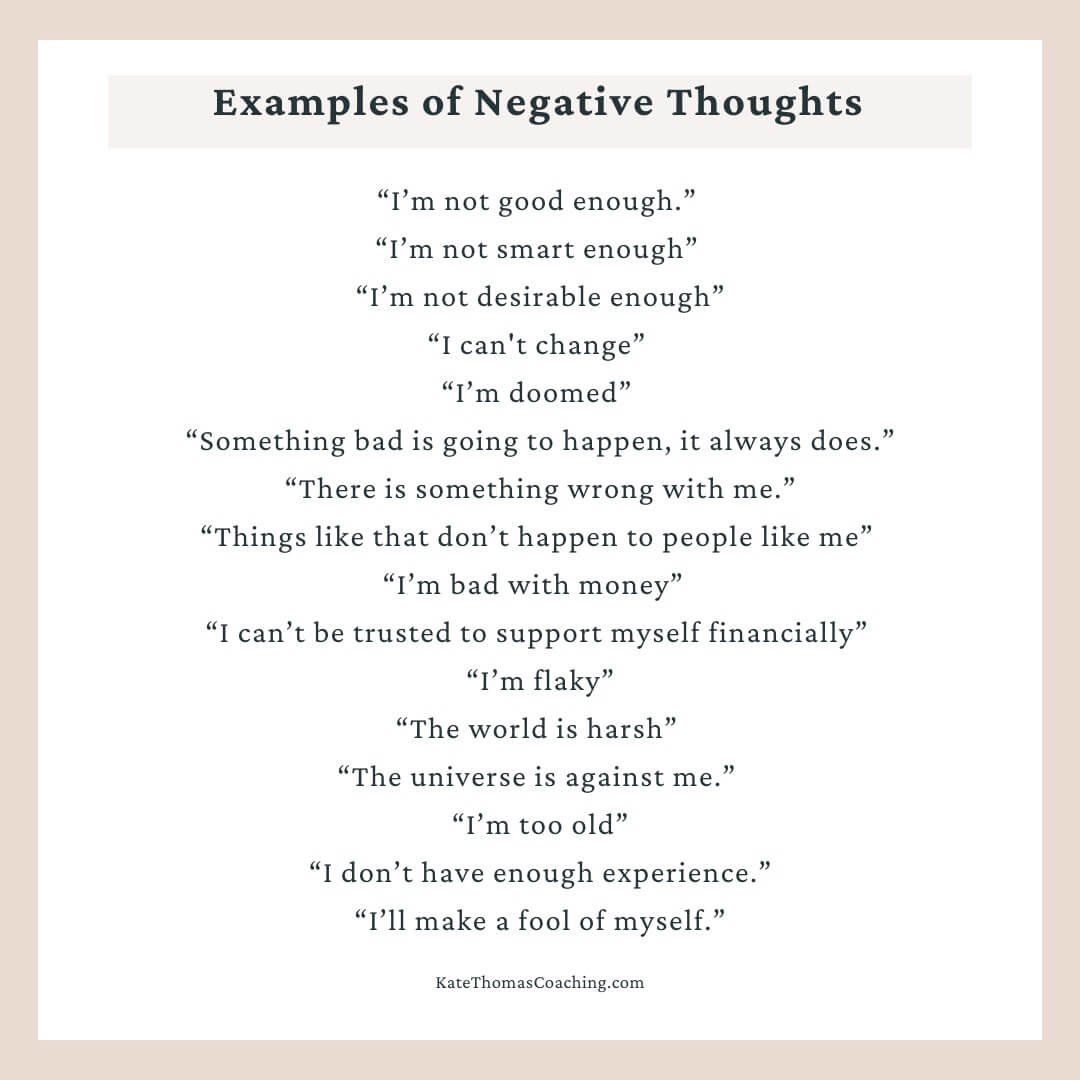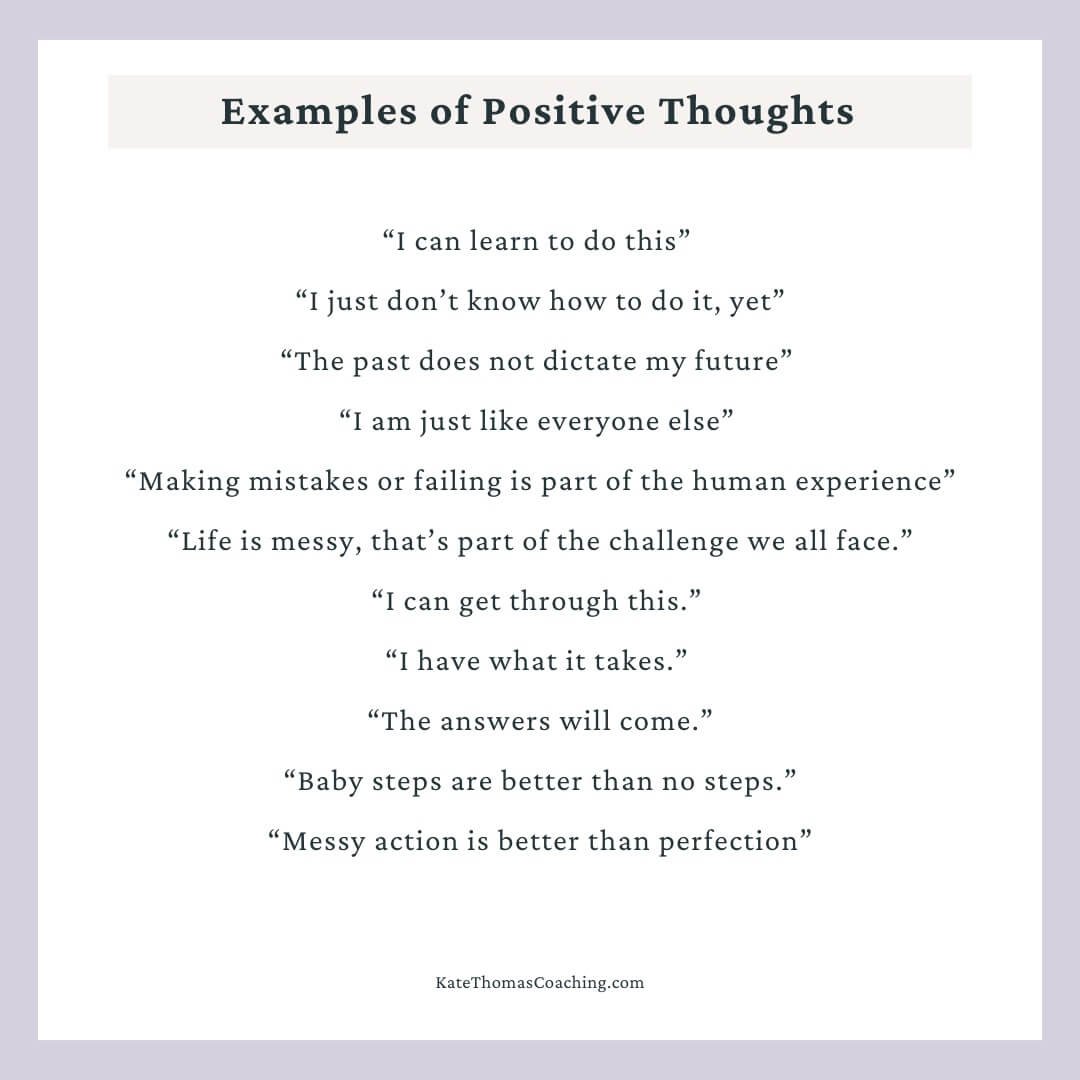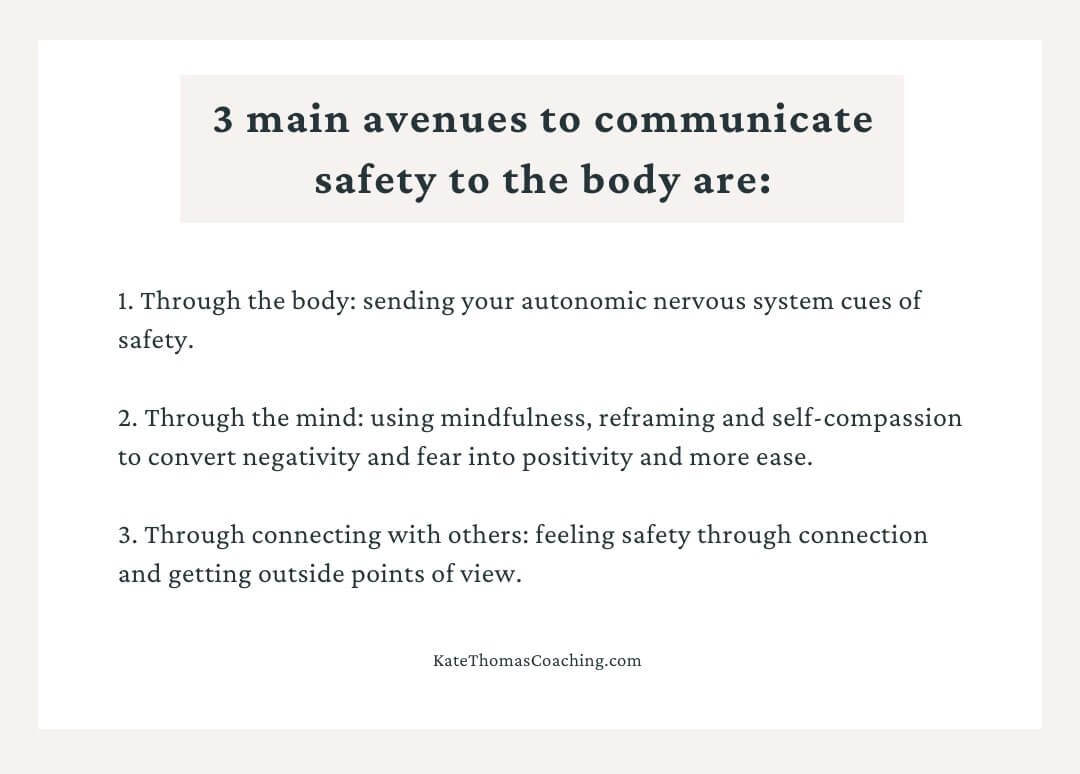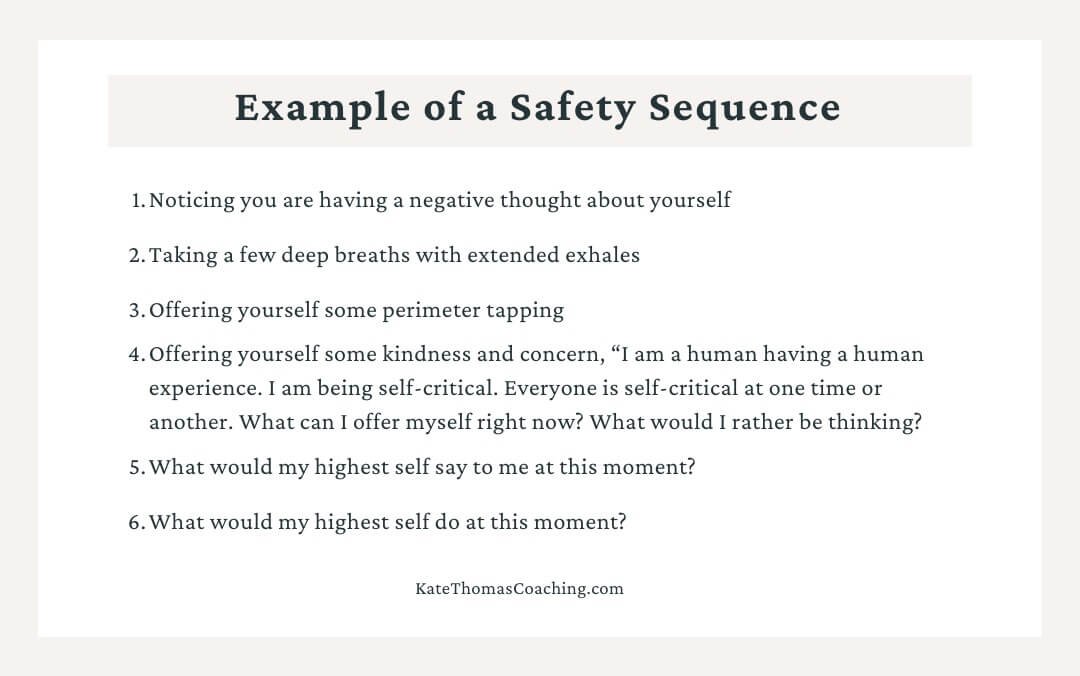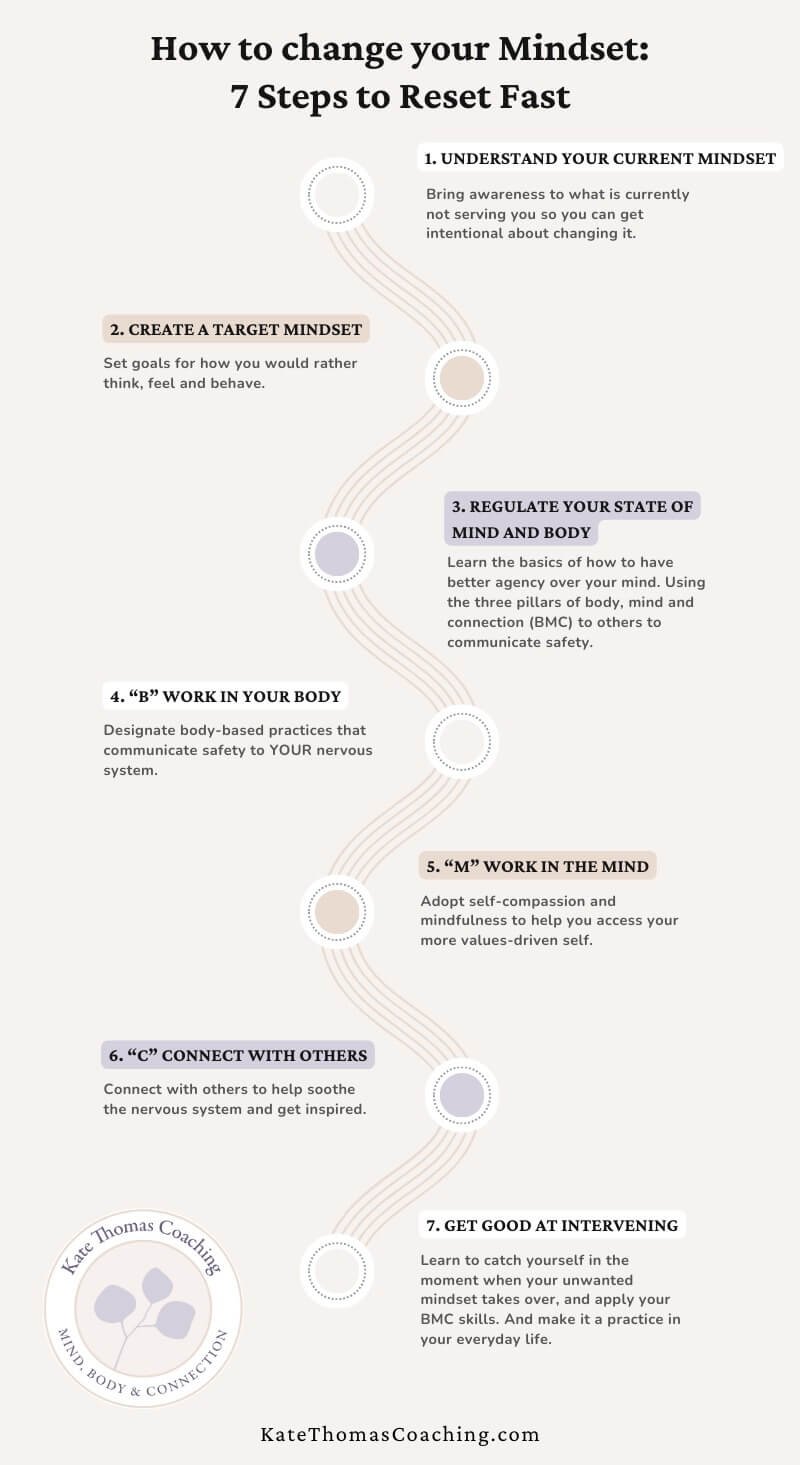How to Change Your Mindset: 7 Steps to Create a Permanent Shift
You’re about to discover a powerful method that will show you how to change your mindset in a profound and lasting way.
This is a process that has worked time and again with my clients, as I guide them through to the transformation they desire.
Roll up your sleeves. Let’s get into it, step by step.
Table of Contents
- 1. Understand Your Current Mindset
- 2. Identify What You Would Rather Think and Feel
- 3. Get Good at Communicating Safety
- 4. Use Body-Based Techniques to Change Your State of Mind
- 5. Adopt a Mindful and Self-Compassionate Inner Voice
- 6. Connect with Others to Feel Safe and Gain New Perspectives
- 7. Get Good at Awareness and Intervention
- Conclusion
- FAQs
1. Understand Your Current Mindset
To change your mindset, you first need to identify the deeper, less empowering perspectives and beliefs contributing to it.
There's a simple process you can follow to bring them to your conscious awareness. It’s designed to transform self-criticism, negativity, or scarcity into powerful inner resources.
Here it is.
First, bring to mind a time that you were struggling with the very things you want to change. For example, if you struggle with imposter syndrome, recall a time you felt like you didn't belong. Embody the state you were in at that time by visualizing that moment in detail. Be careful not to choose anything too overwhelming or difficult to relive.
Once you are in the state, pull out a journal and write your answers to the following questions. Give yourself the freedom to free-write as if you were sharing with a trusted friend. These questions are meant to help you mine your inner landscape for key insights.
(In a coaching session, I would be gently guiding you through questions like these.)
What is going on right now?
What story am I telling myself about this situation?
What triggered me into this state?
From this vantage point, what do I believe about myself to be true?
From this vantage point, what do I believe about my place in the world?
From this vantage point, what do I believe about my deepest desired goals?
What do those beliefs mean about my future?
How does this feel in my body?
Is there a specific place in my body where I feel discomfort?
What does this physical sensation of discomfort (tightness, pain, pressure, butterflies) feel like? Is it more on the left or right? Front or back of my body?
What less desirable actions do I take to soothe or avoid these uncomfortable states of mind and body? (Go to social media, open the fridge… etc)
Next, look back at your answers and pull out sentences you heard yourself think. Maybe these were new thoughts or old ones you recognize. Either way, if they came up in this exercise, it means they are thoughts that are running in the background and guiding your mindset.
These are your “default settings”.
To define default settings, let’s pull from the wisdom of James Clear and his phenomenal book, Atomic Habits, where he wrote:
"You do not rise to the level of your goals. You fall to the level of your systems."
Your default settings affect the way you feel. They dictate your thoughts and your actions. And ultimately, they drive your life.
Reminder: we all have pesky default settings! For some strange reason, this is part of the human condition. But the good news is that they can be reset.
2. Identify What You Would Rather Think and Feel
For the second step, shift to thinking about what you want. Really want. We need to choose and define better target default settings.
Put your pen back to paper and answer these questions:
How would you rather be feeling in this situation?
What would you rather believe about yourself? (... even if it seems impossible right now)
What is a better story (or stories) you’d like to tell about yourself?
What is a better story (or stories) you would like to tell about your place in the world?
What is a better story (or stories) you would like to believe about your future?
Can you recall a time when you saw yourself rise to the occasion in a way you admire or would serve as a model?
What version of yourself was leading—or would need to lead—in that example for these better stories to become your reality?
What would prefer your inner dialogue to sound like?
Your answers will look something like this:
If you have trouble with this second exercise—if the answers still feel inaccessible—I have a powerful guided visualization that will help you access your inner wisdom. You can access it immediately for free HERE.
3. Get Good at Communicating Safety
“I just want you to know. It ain't where I been but where I'm 'bout to go” - Jay Z
You’ve taken stalk of where you are now and where you want to go. And no doubt, objections are starting to pop into your mind. You may feel skeptical of how you are going to bridge the gap between your current state and your desired state.
Those skeptical thoughts, often disguised as pragmatic thoughts, arise because something inside of you is sounding an alarm. A part of you believes that moving forward with new beliefs and perspectives puts you at risk. It is the same alarm that sounds when you soak in your default settings (step #1).
When that alarm goes off inside you, it provokes a threat response in your body (ie. fight-or-flight, shutdown).
Maybe you feel uncertain. Like, “Ah, I don’t know what is going to happen!”
Maybe you have realistic concerns about the outcome of whatever it is you are trying to achieve or overcome.
Maybe that alarm is rooted in deeper experiences from the past.
Regardless of why your body is going into threat response (absent an actual physical threat), that reaction is putting you in a state that hinders your ability to change your mindset and overcome the challenges you face.
So your job is to learn how to communicate safety in your body. It is to alchemize those feelings so that you can come back to the present moment, feel grounded, and get out of the swirl of thoughts and emotions that are clouding your perspective. At its essence, you are trying to decouple external circumstances from your inner experience. You want to get agency over your state of mind and body.
From a present, safe, and grounded place, you can more easily access your inner resources—intelligence, problem-solving skills, confidence, and creativity. From here, you can also better connect with other people. This is often the strongest catalyst for change.
The concept of communicating safety to the body for nervous system regulation comes from the work of Dr. Steven Porges and The Polyvagal Theory.
“Basically, when humans feel safe, their nervous systems support the homeostatic functions of health, growth, and restoration, while they simultaneously become accessible to others…” - Dr. Steven Porges
There are many proven and practiced ways to communicate safety to the body. The three main avenues to communicate safety to the body are BMC:
Body: giving your autonomic nervous system and vagus nerve cues that you are safe.
Mind: using mindfulness, reframing and self-compassion
Connecting with others: co-regulating your nervous system and getting an outside perspective
There’s no one-size-fits-all approach. Everyone has unique preferences, life experiences, pre-dispositions, and so on. So you will need to play around with different techniques and cherry-pick the ones that work for you.
Aim to build your own sequence of "safety" exercises - it will be the most powerful resilience tool for your life!
Here’s an example of a sequence:
Noticing you are having a negative thought about yourself
Taking a few deep breaths with extended exhales
Perimeter tapping
Speaking words of self-compassion: “I am a human having a human experience. I am being self-critical. Everyone is self-critical at one time or another. What can I offer myself right now? What would I rather be thinking?
What would my highest self say to me and/or at this moment?
What would my highest self do at this moment?
4. Use Body-Based Techniques to Change Your State of Mind
Thinking one's way out of negative thoughts is tough. Body-based exercises leverage the connection between the mind and body. They make changing your state of mind easier. Though there are many options, below are two popular techniques:
a. Breathwork
Breathwork grounds you in the present moment. It sends signals to your body that affect your heart rate and other processes responsible for your mindset.
The Physiological Sigh is one breathwork technique recently popularized by Dr. Andrew Huberman. To do it, you take one deep breath in through the nose. At the top of the breath, take another sharp inhale, filling your lungs even further. Then let it all out through one big exhale through the mouth.
Coherent Breathing is another research-backed technique for regulating your state. It is a pattern of breath where you breathe in and breathe out for exactly 5.5 seconds each for 3 to 5 minutes at a time.
And there's the good old Extended Out-Breath technique, where you breathe out twice as long as you breathe in, e.g., 4 seconds in, 8 seconds out.
b. Movement
Movement helps in so many ways. It directs focus out of your head. But it also impacts hormones, improves circulation, and changes the state of your nervous system. Here are simple movement techniques you can use daily to shift your mindset:
Go for a walk outside. If you can find a place with some nature and where you feel safe, that is best.
Try Perimeter Tapping. Bring your attention to the edges of your body. This helps you ground yourself in the moment. See this demo—perimeter tapping is the second exercise in the sequence.
Try Progressive Muscle Group Tensing. I show you how to do it in this short Instagram Reel.
Other great somatic practices include stretching, shaking out body parts, or dancing to an uplifting song.
5. Adopt a Mindful and Self-Compassionate Inner Voice
Self-compassion is speaking to yourself as you would to a good friend. And it turns out, we need to be kind to ourselves if we want to feel good, find fulfillment, heal, and promote health. That may very well be because self-compassion helps communicate safety to your body.
Dr. Kristin Neff, a pioneer in the research and spread of self-compassion explains it best. When you are experiencing inner turmoil, you are simply having a human experience. It is an opportunity to offer yourself kindness, everything changes.
Realizing and embracing that fact can be transformative.
Self-kindness is fundamental in diffusing any blocks, procrastination, fears, or traumas. It is a prerequisite to personal responsibility, achieving your goals over the long term, and changing your mindset.
So how do we do it? Dr. Kristen Neff shares this simple yet powerful technique:
“Whenever I notice something about myself I don’t like, or whenever something goes wrong in my life, I silently repeat the following phrases: 'This is a moment of suffering. Suffering is part of life. May I be kind to myself in this moment. May I give myself the compassion I need.'”
To become self-compassionate, you have to watch negative thoughts from a third-person perspective. Like in mindfulness. “Oh! I’m having a negative thought.” “I am a human having negative thoughts.”
This way, you create distance between yourself and your thoughts. This space allows you to realize you are not your thoughts and that all your thoughts are not facts.
When you over-identify with negative thoughts (self-criticism, skepticism, and pessimism), remind yourself it is part of the human experience. Negative thoughts can seem like they are protecting oneself against a threat—sensed consciously or unconsciously. And when you let down your defensiveness and replace it with self-compassion, you make way for growth.
Try telling yourself”: “I am a human feeling resistance to change. If I wasn’t feeling resistance, I might let myself think or believe [insert your statements from exercise #2].”
6. Connect with Others to Feel Safe and Gain New Perspectives
Developing rich relationships and deep connections with people in your life will help you adopt the mindset you desire. Because safe connection promotes feelings of safety.
Have you ever noticed that after a catch-up with a good friend, the way you feel inside shifts for the better? That’s because, as humans, we are wired for connection. We need to feel heard and seen to avoid feeling alone, which helps us feel safe.
So, when you feel self-critical, fearful, worrisome, or pessimistic, you can connect with a trusted friend, family member, mentor, therapist, or coach to shift your state of mind. This is the time to lean into connection, not isolate! And because you have learned to be self-compassionate, you know there is nothing to feel shame for. You understand that everyone experiences difficult moments, blocks, and fears.
But do note, you will need to be choosy for this technique to work.
Not everyone is a safe person to rely upon. You want to pick individuals who are particularly kind and supportive. People who can provide helpful perspectives on what you are working through.
When I was first starting my business, I would sometimes get discouraged and scared. It felt as though things were not moving forward fast enough. When I would come to family members, they would sometimes echo back the same doubt and fear I was feeling. This was counterproductive!
That is when I decided to reach out to a friend who is building her own business—like me, but a few stages ahead.
The result? We could provide support for each other, cheerleading and uplifting each other. I called her when I was low. She called me when she was low. And we made it a point to have fun together, too!
The more people you surround yourself with who can support you, the easier it will feel to maintain a positive mindset. Things will feel more doable, especially if the people you choose are on a parallel path to yours.
So, who comes to mind in your life who you already feel you have this dynamic with or with whom you could develop it?
7. Get Good at Awareness and Intervention
The next step is to learn to recognize negative mindsets when they show up.
Awareness doesn’t come easy at first. Often, we don’t realize when we are using our default settings until we have been soaking in them for some time.
So the next step in changing your mindset for real—for the long term—is going to be getting good at awareness. You're going to learn to spot negative thoughts, sensations, and states of mind as soon as they arise.
Here is how to do it.
Go back to your answers from exercise #1. There, you will find the recurring thoughts, sensations, and actions you use to self-soothe and avoid. Make a mental note to be on the lookout for them.
And as soon as you become aware that they are happening, congratulate yourself! That is a huge win.
At first, your only goal is to become aware that things are happening. Get good at catching yourself earlier and earlier on in the pattern. Often I invite my clients to spend a week or so getting good at spotting the unwanted states - with no pressure of having to change it.
Then, you introduce safety cues. Specifically, the sequence of safety cues that you worked out in step 3.
As a reminder, here’s the example we used earlier. This is just an example. Yours will look different and you will likely develop more than one.
Conclusion
The more you do this, the easier it gets. And in time, this new way of relating and resourcing yourself will become a habit.
At first, it will feel hard and clunky.
But do it again and again. Use the techniques every time you notice a negative thought pattern or state of mind. And with time, you will get better and better at noticing when it is happening. You will get better and better at shifting your mindset.
With practice, you will begin to reprogram your mind. You will soon default to self-compassion, safety, and empowering thoughts in every situation. Free to continue your day. Free to stay connected to your most resourceful and powerful self.
FAQs
Why is it so hard to change your mindset?
There are two reasons why shifting mindset is not as simple as writing a motivational quote on a Post-it note.
The first is that it requires introspection and self-awareness. To change your mindset, you need to go through a stage of deep introspection. Only then can you understand why you default to negative mindsets. Not everyone knows they need to do this, but most importantly, not everyone is willing to.
The second reason is that changing one's mindset takes commitment. To reprogram your mind, you need to practice consistently over time.
How long does it take to change your mindset?
How long it takes to change your mindset varies based on many variables. On your own, if you stay dedicated to practices like the ones above, you can change your mindset in a few months.
Through coaching, I find that even a couple of sessions can lead to a significant shift in mindset. Regardless of how you change your mindset, it is important to stay aware of when you slip back into old thinking. Every slip backward is an opportunity to improve.
How do I start changing my mindset?
The process outlined above is a very effective way to shift your mindset. Understand your starting point. Define your target mindset. Learn to communicate safety to your nervous system. Get good at catching yourself in your default mindset. Get good at intervening. Make all this a habit, and reprogram your mindset over time.
You can speed up this process by working with a coach. It’s the coaching that provides accountability and support. And ultimately, a coach will inspire consistency and continuity, which are prerequisites for lasting change.
What are the 4 basic mindsets if you want to succeed?
The four basic mindsets that help you succeed are:
Growth Mindset: “I don’t know how to do this, but I can learn.”
Positive Mindset: “I know there are positive and negative aspects of myself and of life. I choose to focus on the positive.”
Challenge Mindset: “When I am facing an obstacle or something difficult, I see it as a challenge - an opportunity to improve and grow.”
Entrepreneurial Mindset. “Nothing is fixed so I must always be learning, adapting, pivoting, and innovating. And I accept that risk is part of the game.”
What hobbies evolve your mindset?
Three kinds of hobbies will help you change your mindset.
Hobbies that make you spend time with others. Ideally, these are people who already embody the mindset you seek or who are also on the journey to embody the mindset you desire. Think group sports, book clubs, writers groups, public speaking workshops, etc.
Hobbies that make you experience a bit of hardship, struggle, or pain. Doing hard things helps you feel accomplished and thus more willing to take on more hard things.
Hobbies that contradict the mindset you are trying to transform. For example, say you're a workaholic mom who's struggling with self-care. A hobby that would make focus on yourself and care for yourself would help to break the pattern. It could be yoga, reading, meditation, monthly spa visits, or solo dates.

